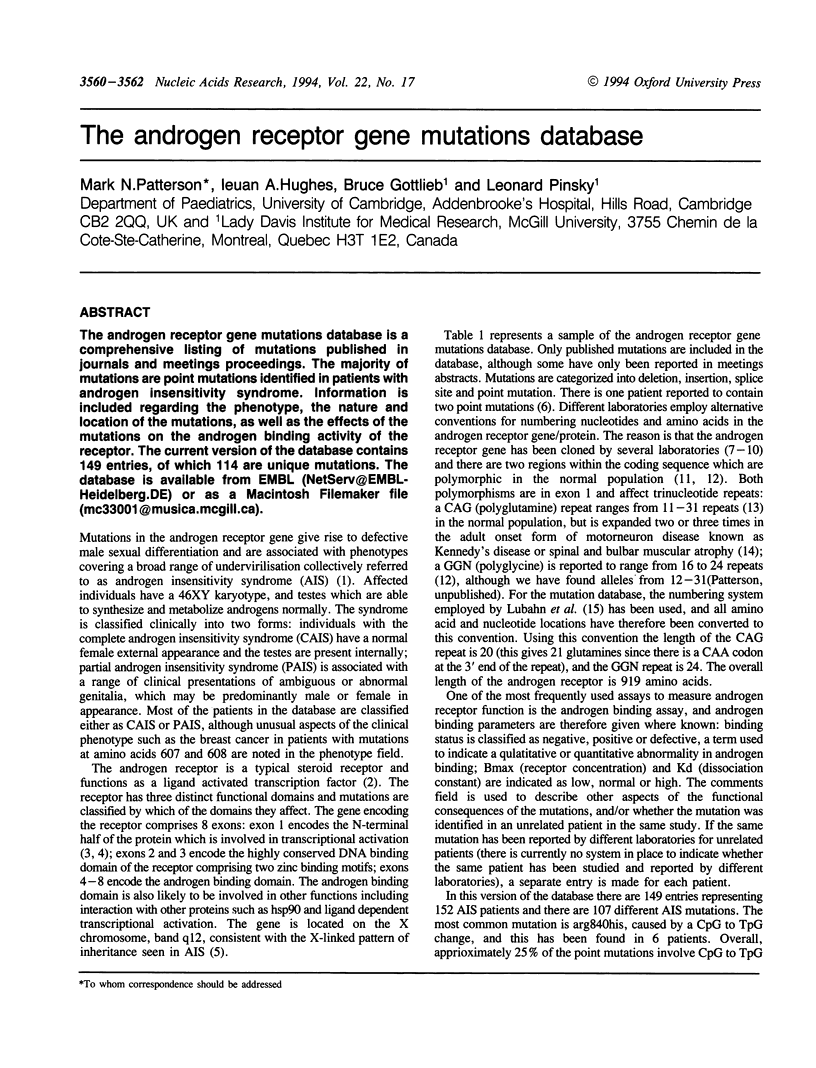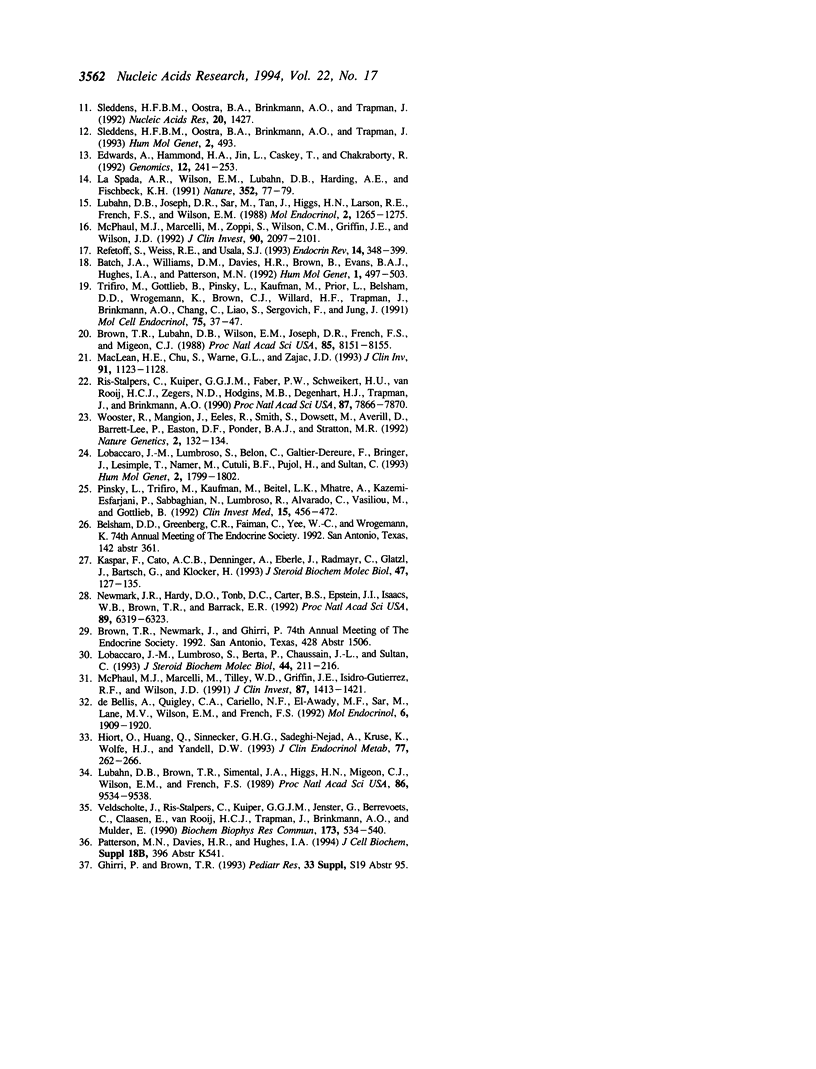Abstract
The androgen receptor gene mutations database is a comprehensive listing of mutations published in journals and meetings proceedings. The majority of mutations are point mutations identified in patients with androgen insensitivity syndrome. Information is included regarding the phenotype, the nature and location of the mutations, as well as the effects of the mutations on the androgen binding activity of the receptor. The current version of the database contains 149 entries, of which 114 are unique mutations. The database is available from EMBL (NetServ@EMBL-Heidelberg.DE) or as a Macintosh Filemaker file (mc33001@musica.mcgill.ca).
Full text
PDF


Selected References
These references are in PubMed. This may not be the complete list of references from this article.
- Batch J. A., Williams D. M., Davies H. R., Brown B. D., Evans B. A., Hughes I. A., Patterson M. N. Androgen receptor gene mutations identified by SSCP in fourteen subjects with androgen insensitivity syndrome. Hum Mol Genet. 1992 Oct;1(7):497–503. doi: 10.1093/hmg/1.7.497. [DOI] [PubMed] [Google Scholar]
- Brown C. J., Goss S. J., Lubahn D. B., Joseph D. R., Wilson E. M., French F. S., Willard H. F. Androgen receptor locus on the human X chromosome: regional localization to Xq11-12 and description of a DNA polymorphism. Am J Hum Genet. 1989 Feb;44(2):264–269. [PMC free article] [PubMed] [Google Scholar]
- Brown T. R., Lubahn D. B., Wilson E. M., Joseph D. R., French F. S., Migeon C. J. Deletion of the steroid-binding domain of the human androgen receptor gene in one family with complete androgen insensitivity syndrome: evidence for further genetic heterogeneity in this syndrome. Proc Natl Acad Sci U S A. 1988 Nov;85(21):8151–8155. doi: 10.1073/pnas.85.21.8151. [DOI] [PMC free article] [PubMed] [Google Scholar]
- Carson-Jurica M. A., Schrader W. T., O'Malley B. W. Steroid receptor family: structure and functions. Endocr Rev. 1990 May;11(2):201–220. doi: 10.1210/edrv-11-2-201. [DOI] [PubMed] [Google Scholar]
- Chang C. S., Kokontis J., Liao S. T. Molecular cloning of human and rat complementary DNA encoding androgen receptors. Science. 1988 Apr 15;240(4850):324–326. doi: 10.1126/science.3353726. [DOI] [PubMed] [Google Scholar]
- De Bellis A., Quigley C. A., Cariello N. F., el-Awady M. K., Sar M., Lane M. V., Wilson E. M., French F. S. Single base mutations in the human androgen receptor gene causing complete androgen insensitivity: rapid detection by a modified denaturing gradient gel electrophoresis technique. Mol Endocrinol. 1992 Nov;6(11):1909–1920. doi: 10.1210/mend.6.11.1480178. [DOI] [PubMed] [Google Scholar]
- Edwards A., Hammond H. A., Jin L., Caskey C. T., Chakraborty R. Genetic variation at five trimeric and tetrameric tandem repeat loci in four human population groups. Genomics. 1992 Feb;12(2):241–253. doi: 10.1016/0888-7543(92)90371-x. [DOI] [PubMed] [Google Scholar]
- Hiort O., Huang Q., Sinnecker G. H., Sadeghi-Nejad A., Kruse K., Wolfe H. J., Yandell D. W. Single strand conformation polymorphism analysis of androgen receptor gene mutations in patients with androgen insensitivity syndromes: application for diagnosis, genetic counseling, and therapy. J Clin Endocrinol Metab. 1993 Jul;77(1):262–266. doi: 10.1210/jcem.77.1.8325950. [DOI] [PubMed] [Google Scholar]
- Jenster G., van der Korput H. A., van Vroonhoven C., van der Kwast T. H., Trapman J., Brinkmann A. O. Domains of the human androgen receptor involved in steroid binding, transcriptional activation, and subcellular localization. Mol Endocrinol. 1991 Oct;5(10):1396–1404. doi: 10.1210/mend-5-10-1396. [DOI] [PubMed] [Google Scholar]
- Kaspar F., Cato A. C., Denninger A., Eberle J., Radmayr C., Glatzl J., Bartsch G., Klocker H. Characterization of two point mutations in the androgen receptor gene of patients with perineoscrotal hypospadia. J Steroid Biochem Mol Biol. 1993 Dec;47(1-6):127–135. doi: 10.1016/0960-0760(93)90066-6. [DOI] [PubMed] [Google Scholar]
- La Spada A. R., Wilson E. M., Lubahn D. B., Harding A. E., Fischbeck K. H. Androgen receptor gene mutations in X-linked spinal and bulbar muscular atrophy. Nature. 1991 Jul 4;352(6330):77–79. doi: 10.1038/352077a0. [DOI] [PubMed] [Google Scholar]
- Lobaccaro J. M., Lumbroso S., Belon C., Galtier-Dereure F., Bringer J., Lesimple T., Namer M., Cutuli B. F., Pujol H., Sultan C. Androgen receptor gene mutation in male breast cancer. Hum Mol Genet. 1993 Nov;2(11):1799–1802. doi: 10.1093/hmg/2.11.1799. [DOI] [PubMed] [Google Scholar]
- Lobaccaro J. M., Lumbroso S., Berta P., Chaussain J. L., Sultan C. Complete androgen insensitivity syndrome associated with a de novo mutation of the androgen receptor gene detected by single strand conformation polymorphism. J Steroid Biochem Mol Biol. 1993 Mar;44(3):211–216. doi: 10.1016/0960-0760(93)90081-7. [DOI] [PubMed] [Google Scholar]
- Lubahn D. B., Brown T. R., Simental J. A., Higgs H. N., Migeon C. J., Wilson E. M., French F. S. Sequence of the intron/exon junctions of the coding region of the human androgen receptor gene and identification of a point mutation in a family with complete androgen insensitivity. Proc Natl Acad Sci U S A. 1989 Dec;86(23):9534–9538. doi: 10.1073/pnas.86.23.9534. [DOI] [PMC free article] [PubMed] [Google Scholar]
- Lubahn D. B., Joseph D. R., Sar M., Tan J., Higgs H. N., Larson R. E., French F. S., Wilson E. M. The human androgen receptor: complementary deoxyribonucleic acid cloning, sequence analysis and gene expression in prostate. Mol Endocrinol. 1988 Dec;2(12):1265–1275. doi: 10.1210/mend-2-12-1265. [DOI] [PubMed] [Google Scholar]
- Lubahn D. B., Joseph D. R., Sullivan P. M., Willard H. F., French F. S., Wilson E. M. Cloning of human androgen receptor complementary DNA and localization to the X chromosome. Science. 1988 Apr 15;240(4850):327–330. doi: 10.1126/science.3353727. [DOI] [PubMed] [Google Scholar]
- MacLean H. E., Chu S., Warne G. L., Zajac J. D. Related individuals with different androgen receptor gene deletions. J Clin Invest. 1993 Mar;91(3):1123–1128. doi: 10.1172/JCI116271. [DOI] [PMC free article] [PubMed] [Google Scholar]
- McPhaul M. J., Marcelli M., Tilley W. D., Griffin J. E., Isidro-Gutierrez R. F., Wilson J. D. Molecular basis of androgen resistance in a family with a qualitative abnormality of the androgen receptor and responsive to high-dose androgen therapy. J Clin Invest. 1991 Apr;87(4):1413–1421. doi: 10.1172/JCI115147. [DOI] [PMC free article] [PubMed] [Google Scholar]
- McPhaul M. J., Marcelli M., Zoppi S., Wilson C. M., Griffin J. E., Wilson J. D. Mutations in the ligand-binding domain of the androgen receptor gene cluster in two regions of the gene. J Clin Invest. 1992 Nov;90(5):2097–2101. doi: 10.1172/JCI116093. [DOI] [PMC free article] [PubMed] [Google Scholar]
- Newmark J. R., Hardy D. O., Tonb D. C., Carter B. S., Epstein J. I., Isaacs W. B., Brown T. R., Barrack E. R. Androgen receptor gene mutations in human prostate cancer. Proc Natl Acad Sci U S A. 1992 Jul 15;89(14):6319–6323. doi: 10.1073/pnas.89.14.6319. [DOI] [PMC free article] [PubMed] [Google Scholar]
- Pinsky L., Trifiro M., Kaufman M., Beitel L. K., Mhatre A., Kazemi-Esfarjani P., Sabbaghian N., Lumbroso R., Alvarado C., Vasiliou M. Androgen resistance due to mutation of the androgen receptor. Clin Invest Med. 1992 Oct;15(5):456–472. [PubMed] [Google Scholar]
- Refetoff S., Weiss R. E., Usala S. J. The syndromes of resistance to thyroid hormone. Endocr Rev. 1993 Jun;14(3):348–399. doi: 10.1210/edrv-14-3-348. [DOI] [PubMed] [Google Scholar]
- Ris-Stalpers C., Kuiper G. G., Faber P. W., Schweikert H. U., van Rooij H. C., Zegers N. D., Hodgins M. B., Degenhart H. J., Trapman J., Brinkmann A. O. Aberrant splicing of androgen receptor mRNA results in synthesis of a nonfunctional receptor protein in a patient with androgen insensitivity. Proc Natl Acad Sci U S A. 1990 Oct;87(20):7866–7870. doi: 10.1073/pnas.87.20.7866. [DOI] [PMC free article] [PubMed] [Google Scholar]
- Simental J. A., Sar M., Lane M. V., French F. S., Wilson E. M. Transcriptional activation and nuclear targeting signals of the human androgen receptor. J Biol Chem. 1991 Jan 5;266(1):510–518. [PubMed] [Google Scholar]
- Sleddens H. F., Oostra B. A., Brinkmann A. O., Trapman J. Trinucleotide (GGN) repeat polymorphism in the human androgen receptor (AR) gene. Hum Mol Genet. 1993 Apr;2(4):493–493. doi: 10.1093/hmg/2.4.493. [DOI] [PubMed] [Google Scholar]
- Sleddens H. F., Oostra B. A., Brinkmann A. O., Trapman J. Trinucleotide repeat polymorphism in the androgen receptor gene (AR). Nucleic Acids Res. 1992 Mar 25;20(6):1427–1427. doi: 10.1093/nar/20.6.1427-a. [DOI] [PMC free article] [PubMed] [Google Scholar]
- Tilley W. D., Marcelli M., Wilson J. D., McPhaul M. J. Characterization and expression of a cDNA encoding the human androgen receptor. Proc Natl Acad Sci U S A. 1989 Jan;86(1):327–331. doi: 10.1073/pnas.86.1.327. [DOI] [PMC free article] [PubMed] [Google Scholar]
- Trapman J., Klaassen P., Kuiper G. G., van der Korput J. A., Faber P. W., van Rooij H. C., Geurts van Kessel A., Voorhorst M. M., Mulder E., Brinkmann A. O. Cloning, structure and expression of a cDNA encoding the human androgen receptor. Biochem Biophys Res Commun. 1988 May 31;153(1):241–248. doi: 10.1016/s0006-291x(88)81214-2. [DOI] [PubMed] [Google Scholar]
- Trifiro M., Gottlieb B., Pinsky L., Kaufman M., Prior L., Belsham D. D., Wrogemann K., Brown C. J., Willard H. F., Trapman J. The 56/58 kDa androgen-binding protein in male genital skin fibroblasts with a deleted androgen receptor gene. Mol Cell Endocrinol. 1991 Jan;75(1):37–47. doi: 10.1016/0303-7207(91)90243-l. [DOI] [PubMed] [Google Scholar]
- Veldscholte J., Ris-Stalpers C., Kuiper G. G., Jenster G., Berrevoets C., Claassen E., van Rooij H. C., Trapman J., Brinkmann A. O., Mulder E. A mutation in the ligand binding domain of the androgen receptor of human LNCaP cells affects steroid binding characteristics and response to anti-androgens. Biochem Biophys Res Commun. 1990 Dec 14;173(2):534–540. doi: 10.1016/s0006-291x(05)80067-1. [DOI] [PubMed] [Google Scholar]
- Wooster R., Mangion J., Eeles R., Smith S., Dowsett M., Averill D., Barrett-Lee P., Easton D. F., Ponder B. A., Stratton M. R. A germline mutation in the androgen receptor gene in two brothers with breast cancer and Reifenstein syndrome. Nat Genet. 1992 Oct;2(2):132–134. doi: 10.1038/ng1092-132. [DOI] [PubMed] [Google Scholar]
- Zoppi S., Marcelli M., Deslypere J. P., Griffin J. E., Wilson J. D., McPhaul M. J. Amino acid substitutions in the DNA-binding domain of the human androgen receptor are a frequent cause of receptor-binding positive androgen resistance. Mol Endocrinol. 1992 Mar;6(3):409–415. doi: 10.1210/mend.6.3.1316540. [DOI] [PubMed] [Google Scholar]


